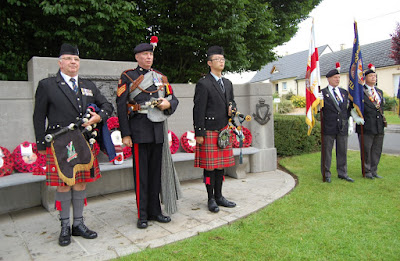 |
| Unknown Somme Soldier #28 |
In summer 1916, whilst the Battle of the Somme was raging less than 10 miles away, hundreds of British soldiers, including men from the Durham Light Iinfantry, had their photographs taken by an enterprising French photographer in the village of Warloy-Baillon.
The photographs, of which the DLI are only a fraction, were brought to the world’s attention by John Lichfield, The Independent’s correspondent in France. Taken by Alfred Dupire, the 500 or so glass plate negatives have been collected from skips and attics across the Somme region by Benrnard Gardin, Dominique Zanardi, and Joel Scribe. They can be identified by the distinctive door that features behind so many of the pictures. You can read more about this on the Independent’s website:
But who were these DLI soldiers? Steve Shannon picks out some information from the photographs:
In early August 1916, the 50th Division, including the 6th, 8th and 9th Battalions DLI of the 151st Brigade, was ordered south from the Ypres Salient to join the fighting on the Somme. Moving by train and route marches, 151 Brigade finally stopped in Baizieux Wood, a few miles south of Warloy-Baillon on 17 August 1916. There, despite days of rain, the three battalions began intensive training for the Somme fighting. The soldiers with special skills, such as the Lewis machine gunners and signallers, received their own special training. And it is possible that the battalions’ buglers and bandsmen, who also doubled as stretcher bearers, received their special training in the hospital complex at Warloy-Baillon.
There are clues in the uniforms and badges being worn by each soldier that may help identify him.
Differently shaped and coloured cloth patches were used to distinguish battalions within a division. If this soldier was part of the 151st Brigade of the 50th Division (as is suspected), then the 6th Battalion DLI wore RED diamonds; the 8th Battalion DLI wore dark BLUE diamonds; and the 9th Battalion DLI wore GREEN diamonds. As 6 DLI’s red diamonds appear black in black & white photos, this soldier was either in the 8th or 9th Battalion DLI.
The private at the top of this post is wearing a khaki Service Dress (SD) tunic, with its closed collar; pleated top pockets; and a patch on each shoulder to prevent wear from rifle and equipment straps. On his left arm is his ‘RP’ brassard (red letters on black?), and above is a triangular cloth ‘battle patch’.
 |
| Unknown Somme Soldier #5 |
If this soldier was part of the 151st Brigade of the 50th Division (as is suspected), then the 6th Battalion DLI wore RED diamonds; the 8th Battalion DLI wore dark BLUE diamonds; and the 9th Battalion DLI wore GREEN diamonds.
On black & white photos, 6 DLI’s RED diamonds appear almost black, so this soldier was almost certainly in the 6th Battalion DLI. And if you look at another soldier in this group, he is wearing the distinctive black buttons worn by the 6th Battalion DLI.
 |
| Unknown Somme Soldier #33 |
This private is wearing the cheaper, simplified khaki Service Dress tunic that was introduced in late 1914, when so many men were enlisting and needing uniforms. This tunic has plain un-pleated top pockets and no extra shoulder patches to prevent wear from rifle and equipment straps.
Unusually, in this collection of Unknown Somme photos, this soldier is wearing his distinctive DLI cap badge in a so-called ‘Gor Blimey’ cap. This soft, woollen, unmilitary-looking cap, issued in 1915 to replace the stiff Service Dress cap, had flaps that could be buttoned under the chin in bad weather or fastened up (as here) when not needed.
There are over 40 men on the Durham at War website from these photographs: Unknown Somme Soldiers
Is one of them your relative?










